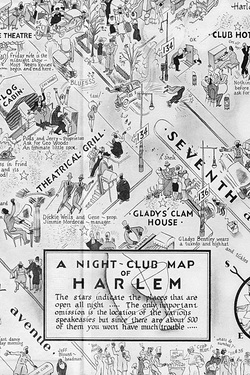 Every year, I finish the year with my 8th graders studying the history and geography of New York City to get them ready for their class trip there in June. We visit Central Park, so we study Central Park ahead of time. We spend time in Times Square, so we study that too. We visit the World Trade Center, Chinatown and the Lower East Side, so we study them, as well. One place we visit, that I haven't always devoted enough time to, is Harlem. For the past several years, one of the highlights of our trip has been visiting the Apollo Theater on 125th St. The students get a tour of the theater, hear stories about its history and even perform on stage. It's really memorable. Except that our almost entirely white student population has no context to put any of it into. Yes, we talk about African-American history throughout the year. We watch, discuss and blog about Roots. We discuss Jim Crow, Plessy Vs. Fergusson and segregation. I try really hard to relate how various historical topics - like Immigration or Jacksonian politics relates to African-Americans. But when it comes right down to it, our well-to-do, white students, who live in a homogenous, rural community in New Hampshire don't really have any way to relate to the Black Urban Experience. So, this year, I decided to tackle the Harlem Renaissance.
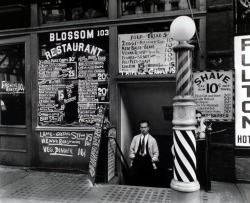 Well, it's over. Over-ish. Okay, the New York City Unit is never really over until we've gotten back from our class trip to New York, and that won't happen for a few more days, but for the most part, the project itself is done. Each year, I wind up the school year with a unit on the history and geography of New York City to get my 8th graders ready for their class trip and to keep them engaged during the slacky, "I'm-so-outa-here" last month of school. (I've written about this before.)
Anyway, this year I decided to shake things up a little bit. The particular class we have this year is much more responsible and conscientious than most, and I felt like I needed to take the opportunity to try one, final, overly-ambitious idea while I still could. If there was a group of students who could pull it off, it would be these guys. So, instead of having them write a term paper on a New York City topic or make a diorama, or something traditional, I asked each of them to pick their topic and make a movie about it. "Then," I said, "let's invite your families in for a New York City film festival. We'll call it the Deer-Becca Film Festival."
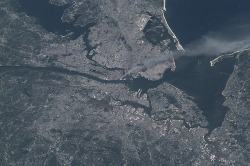 One of the most powerful lessons I teach to my 8th graders each year is about the events of September 11th, 2001. When we first started doing our integrated New York City Unit five or six years ago, my team and I just took it for granted that our students knew about the terrorist attacks of 9-11 and could refer to them in passing and be reasonably sure that our guys would know what we were talking about. By last year, it became clear that that is no longer the case. My current students are fourteen years old, which means that they were in kindergarten in 2001. It is likely that their parents did not let them watch television during the week of the attacks (which I think would have probably been a wise decision). Even if my students were exposed to everything that was going on that week, their understanding of the events would have been that of five year-olds. In the intervening years, it's pretty unlikely that many of the the parents of our guys have sat down and talked through what went on in New York and Washington nine years ago. It's hard enough to have the Sex Talk, the Drug Talk, the Politics Talk (this IS New Hampshire, after all!), the Peer-Pressure Talk and the Did-You-Really-Think-Doing-That-During-A-Wedding-Was-A-Good-Decision? Talk; it really wouldn't occur to most of us to have a 9-11 Talk with our kids. So, last year, I started teaching a one class-period lesson on the events of September 11th. The idea is to present a very factual, step-by-step explanation of the events, so that when we visit the World Trade Center Site on our class trip next month, the students will understand what they are seeing. This is what I've come up with:
When I go to an educational conference, I'm a sucker for sessions that deal with fast-and-dirty, nuts-and-bolts tricks and techniques that I can use in the classroom. Discussions of Educational Philosophy are obviously important and sessions that focus on policy and The Big Picture certainly have their place, but the sessions that I've gotten the most lasting impact from have usually been ones where some veteran teacher has shared a really cool trick that I can adapt and use right away. This past Spring, at the NELMS Annual Conference, I sat in on a session given by that morning's keynote speaker. She seemed funny and approachable and really, really smart - in other words, a good teacher - so I decided to risk some depth and meaning. As it turns out, she was really good and made a lot of really good points, but what really got my attention was an example she gave of a project that she and a Health teacher had come up with for a 6th grade class. They were studying the circulatory system and as they wrapped up the unit, they had the students make t-shirts with the circulatory system drawn on it. Then on a given day, all the students wore their t-shirts and any adult in the building could stop them, point to something on their shirt and say, "Hey - what does that do?" As soon I heard about this, a lightbulb went off in my head. [Just a quick language question - why do we say a lightbulb went off IN our heads, when we mean OVER them, like in a cartoon? And, for that matter, why do we say they went OFF, when we mean ON? But I digress...]Our 8th graders are proud of the amount they learn in their New York City project and would like to be able to show it off. This t-shirt idea seemed like a fun way for them to do that. As soon as the session was over, I cornered Mrs. Faber and asked if she could spare me a moment to give me advice about how best to rip off her idea. She was incredibly gracious and within a minute or two came up with some fantastic guidelines: - Since Geography is a big focus of this unit, have each student draw a map of Manhattan on the back of his or her t-shirt showing where the topic of their New York City project is located.
[Why on the back? To prevent 8th grade boys from poking the girls in the chest, obstensively asking questions about the map. Wow. This lady is good.] - On the front of the shirt, put the title of their project and a Top Five list of interesting facts about it.
- On a given day, have all the students wear their shirts around school. Any adult in the building can stop them and ask them about their projects. If a student gives a good answer, the adult gives them a ticket. The student with the most tickets at the end of the day wins an Impressive Parting Gift. In the case of a tie, we could have a sudden-death Fact-Off to determine who knows the most about their topic.
So I tried it. So far, it's been awesome. Here's how it worked: 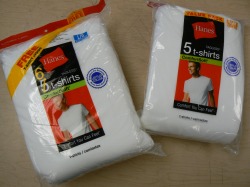 For the t-shirts themselves, I picked up some pocket-less men's undershirts from Walmart. I got mostly Large, with a few Medium and a few more Extra Large undershirts. I tried to mostly grab the packages with a bonus t-shirt in it.
57 t-shirts ran me about $96.
[I considered having each student bring in $2 to pay for their own shirts, but I knew what an exercise in frustration that would be, so I asked around and was able to find enough money in an account at school to re-imburse me.]
Because these t-shirts are only going to be worn for one day, I didn't go out of my way to get thick, high quality, durable shirts. For that matter, we didn't use long-lasting, color-fast dyes or ink to write on them; we used magic markers.
 One thing I did ask students to bring in was empty cereal boxes.
In my mind, I saw students writing on these thin, white t-shirts with black magic markers and the ink bleeding through to the other side of the shirt. By putting a thin piece of cardboard - like a cereal box - inside the shirt while they draw, students could keep their work neater.
As it turns out, the students who are usually the least enthusiastic about getting homework turned in are the most enthusiastic about getting a homework grade for bringing in a cereal box.
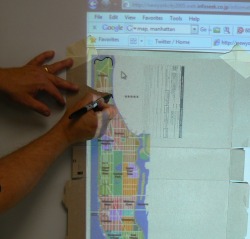
Another really cool use for an empty cereal box:
Tape it to the wall, use your projector to shine a map onto it, trace and cut out the map and you've got a really good stencil of Manhattan for the back of the shirt.
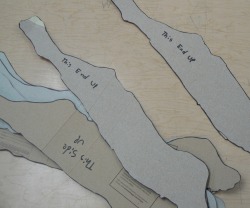
For four classes of up to twenty students, I cut out about a dozen stencils. This turned out to be just about right. I made sure to mark the stencils to indicate which side goes up. It would be a pity to have them show off all their knowledge of Manhattan with the map backwards.
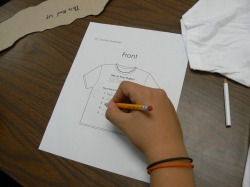 Before any student was given a t-shirt they had to fill out a worksheet showing what they were going to put on it. This was to prevent the inevitable, "Mr. Fladd, I messed up; I need another t-shirt!"
Another bonus is that it let me pre-emptively check their spelling.
 | nyc_tee_shirt_worksheet.doc | | File Size: | 223 kb | | File Type: | doc |
Download File
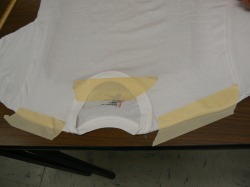 The students were great at figuring out the best way to write on their t-shirts. Within a matter of minutes, they discovered that it was easier to write on the fabric if the t-shirt was stretched tight (with the cereal box inside). The best way to do this was by taping it to a table or the floor with masking tape.
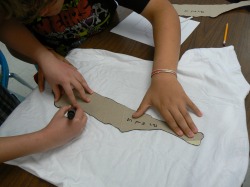 Most of the students ended up working in pairs - at least for the mapping part of the job. It takes two hands to hold the stencil flat and firm against the t-shirt. They discovered that the best marker to use for this part of the project was a standard Sharpie. Short strokes made smoother lines than long ones, which tended to pull the fabric into wrinkles.
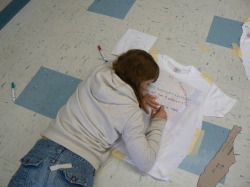
Some of the students felt more comfortable working on the floor.
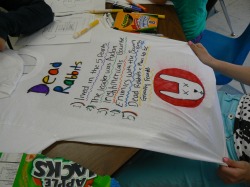
Once students had gotten their basic information down, they were allowed to decorate their shirts however they wanted.
[This girl had researched the 19th Century Irish streetgang, the Dead Rabits.]
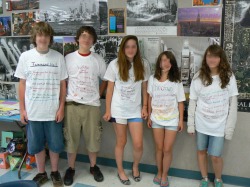
The end results were pretty satisfying. The students were engaged. They demonstrated authentic learning and they had fun.
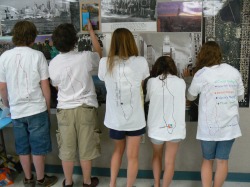
Mind you - at this point, we haven't actually gone through the question-answering process. I'll update you on how that goes next week.
Update (several days later):
Well, we've been through the question-answering process and it seems promising. The students were very motivated for most of the day and were really eager to pigeonhole adults and share information about their projects. Things got a little bit rocky at the end of the day, but with a few tweaks, the process should go much smoother next year.
Glitch #1 - Not Enough Adults To Go Around
Tucked away in our own corner of the school, the 8th graders did not get a chance to really show off their knowledge to new adults unfamiliar with their work. Next year, we should have some sort of reception and invite adults to come look at their projects and do the t-shirt questioning process then, as well as throughout the day.
Glitch #2 - A Few Students Gaming the System
A few of our students got together and pooled their tickets in an explicit attempt to "keep the smart kids from winning". This took a bit of the air out of the second half of the day. We should have anticipated this, but somehow, it slipped under our radar. (To be fair, I had never said that they couldn't do this.) A few of the students gave up at that point, realizing that they couldn't accumalate enough tickets to compete with The Pool.
Next year, even though it will mean more work for the adults, when an adult awards a ticket, we'll have them write the kid's name on the back of it in ink and initial it. Also, we'll award the grand prize based on the number of tickets, but then put all the other tickets into a hat and draw two other winners to keep students motivated.
Glitch #3 - Spoiler
Somehow, one of our students found out what the grand prize was and made sure that all the other students knew within a matter of minutes. This made the end of the day extremely anticlimactic and many of the students came out of the project feeling very dejected. I guess the only way to prevent that next year is to use air-tight security.
Overall Assessment of the T-Shirt Project:
Almost every new project or activity has rough spots the first time through. I think that this t-shirt activity has a lot of promise. We'll try it again next year and see how it goes.
Project Idea Grade - A Minus
Project Execution Grade - B Minus
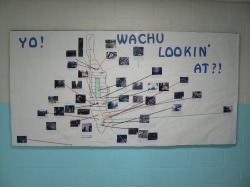 Every year, our 8th graders go to New York City for their Class Trip. It's a pretty big deal. Some of these kids have never been out of New England.
A few years ago, the teachers and advisors on the trip were tearing their hair out at the jaded attitude of our students. Our guys got off the bus, looked around for a moment or two, then said something like, "Huh! Big buildings. When do we go shopping?"
I don't think the phrase "Aaaaaaaargh!!!!" quite covers this situation.
After we got back from the trip that year, the staff did some brainstorming about our too-cool-for-Manhattan students and what we came up with was this:
Why the heck SHOULD they be impressed? What did they know about New York - its history, culture, art, food, etc..? Was it reasonable to expect them to be impressed by something they had no frame of reference to understand?
So every year since then, my 8th grade team has finished up the school year with a big, over-the-top multi-disciplinary unit on the History, Geography, Poetry and Math of New York City. In Social Studies, I devote several weeks to teaching our 8th graders the geography and history of the city. (What is a borough? What is the difference between Manhattan and New York City? What's the big deal about the Brookyln Bridge - I mean, it's just a BRIDGE, after all...? What really happened on 9-11?) This gives me a useful platform to spiral all the concepts we've been learning about all year long - the Constitution, Electoral Politics, Transportation, Immigration, African-American History and Geography. My collegues in Math and Literacy do similarly intensive things in their disciplines.
The difference in student attitudes has been nothing short of astounding. Our guys get off the bus jumping out of their skin with excitement about seeing all the things they've been learning about. They will lecture anyone who stands still long enough about the history of what we are seeing. A couple of years ago, our students told our tour guide so much about the Triangle Shirtwaist Fire and Manhattan schist that he was under the impression that we were from some private school for geniuses up in the hills of New Hampshire. (We're not.)
To finish off the New York City unit before we leave, each student has to complete a New York City project. He or she picks a topic from a long list and becomes an expert on that topic - everything from The History of Central Park to The Best Places to Find Junkfood in Manhattan to Are There Really Alligators in the Sewers?
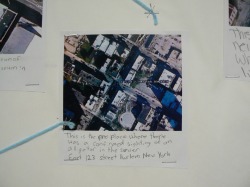 This bulletin board is one way our students display their knowledge. Each of them uses GoogleMaps Streetview or Google Earth to find a street-level or an aerial view of one of the places they have studied in the course of researching his or her project. Each of them does a screen capture of the view on Google, imports it into a graphics program, resizes it, and saves it to a file for printing. When they get the hard copy of their picture, they write a quick identifying sentence/explanation of the picture, then post it on our bulletin board, which has a map of Manhattan traced on it.
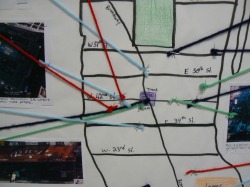 They connect their pictures to the Manhattan map with colored yarn to show where their place is located.
This is an incredibly weird synthesis of high and low tech, but this bulletin board makes a striking visual statement in our hallway. When the material is presented this way, it becomes sort of impressive how much our guys have learned about the topic collectively.
|

















 RSS Feed
RSS Feed